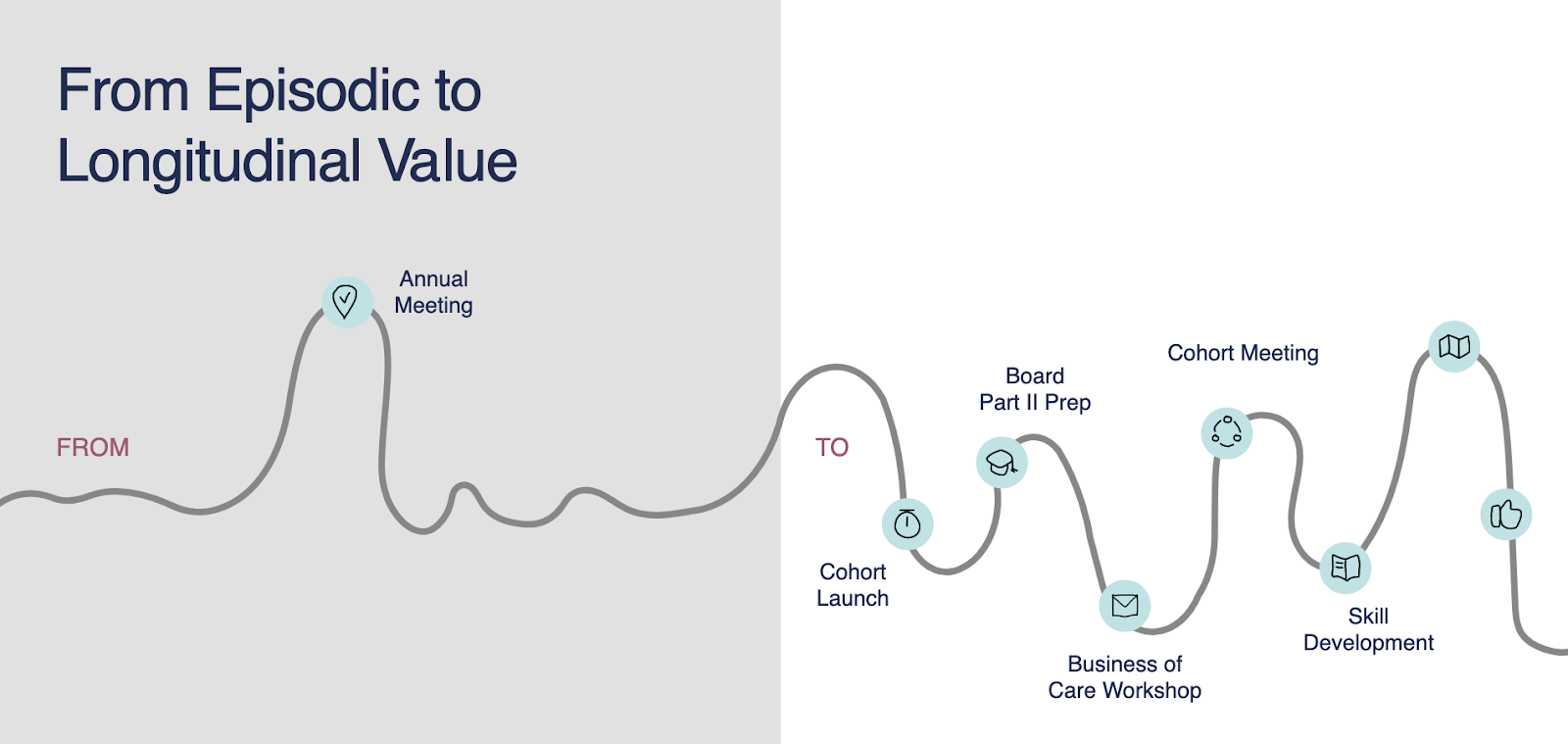
The Bridge Experience gave AAOS a scalable, member-first path to long-term growth.
AAOS faced early career disengagement, threatening long-term member retention.
.png)
AAOS struggled to engage early career members transitioning from training to practice, risking long-term retention and relevance.
AAOS gained a co-created Bridge Experience that deepens engagement, supports transitions, and strengthens retention among early career members.
The Bridge Experience gave AAOS a scalable, member-centered solution that fosters loyalty, relevance, and long-term membership growth.
Overview
The American Academy of Orthopaedic Surgeons (AAOS), the trusted leader in musculoskeletal health, faced a pressing challenge: declining engagement among early-career professionals transitioning from residency to fellowship and early practice.. All US and Canadian orthopaedic residents are automatically granted membership through their Residency Program. Residents are passive joiners and can extend their free period during the one and two-year fellowships that many opt to join. The challenge centers around converting orthopedic surgeons once they go into practice.
To solve this, AAOS partnered with Highland to explore the barriers and motivations affecting this critical member segment—and to co-create a new kind of experience: one that doesn’t just extend membership but deepens its relevance during a period of significant professional transition.
The Challenge: A Retention Cliff
Young orthopaedic surgeons had clear, functional reasons to remain as AAOS Members during residency—access to clinical guidelines, test prep materials, and discounted rates. But once they graduated, the decision to stay wasn’t automatic.
“We saw that our early-career members didn’t understand the value we offered after residency,” said Meghan Randazzo, Director of Membership and Customer Experience at AAOS. “It was like a cliff—they fell off the radar. And we wanted to understand why.”
Highland’s Approach: Collaborative Discovery and Design
AAOS engaged Highland to help them think beyond traditional member benefits and toward a more career-centered experience model. Rather than jumping straight into solutions, Highland led with discovery—starting with in-depth interviews, journey mapping, and facilitated workshops to uncover what these young professionals were really experiencing during their transition out of residency.
“Highland brought a mindset of possibility, but grounded everything in what our members actually told us,” said Randazzo. “It never felt theoretical—it was based on actual research and was actionable.”
Through this research, Highland identified a gap: the transition from residency to early practice wasn’t just a career move. It was a deeply personal and emotional shift—filled with uncertainty, new responsibilities, identity shifts, and career pressure.
The Insight: Joining and Staying Are Two Separate Decisions
One key realization shaped the work ahead: the opportunity to join AAOS during residency and the decision to stay once in practice post-graduation and fellowships after are two distinct moments—each with its own emotional landscape and value proposition.
“The decision to join was functional. The decision to stay was more emotional,” noted Tony Priore, Chief Marketing & Membership Officer at AAOS. “That was a big unlock.”
Highland used this insight to frame the central challenge: How might we create an experience that bridges the emotional, professional, and relational gaps during this period of transition?
Co-Creating the Bridge Experience
Rather than default to a one-size-fits-all communications plan or benefit list, Highland and AAOS designed a dedicated initiative: the bridge experience—an 18-month curated experience for members transitioning out of residency, through Fellowship, and into practice.
Built through design sprints and co-creation with AAOS staff and early-career members, the bridge experience was structured around key themes and emotional moments that surfaced during discovery:
- Making it real: Preparing for the “oh wow” moment when new fellows face real-world pressures.
- Building your network: Helping them feel less isolated and more connected to peers and mentors.
- Owning your identity: Supporting the transition from “resident” to “practicing” surgeon—both in mindset and community.
Each month of the Bridge Experience offered content and interactions tailored to a specific theme. Crucially, it was experience-led, not benefit-led—anchored in real human needs rather than organizational assumptions.
“What impressed us most was how Highland designed not just for the mind, but for the emotional state of our members,” said Randazzo. “They helped us design an experience that felt like AAOS saw them.”

Pilot and Results
AAOS piloted the bridge experience called “Launchpad” with a select group of graduating residents. The program combined practical tools (like job search guidance and credentialing prep resources ) with curated peer discussions, mentor access, and digital prompts tied to each theme.
Participants responded enthusiastically. Engagement rates rose across the pilot group, and feedback validated the core approach: early-career professionals felt more seen, supported, and motivated to continue their relationship with AAOS.
“This was the first time I felt like AAOS understood what I was going through,” one pilot participant noted.
Internally, the pilot also helped AAOS staff shift from a transactional to a relational mindset—creating alignment across departments.
“The work with Highland helped us think more holistically,” said Priore. “It was a catalyst for broader change across our member strategy.”
Key Takeaways
1. Transitions Are Moments of Opportunity
Instead of seeing post-residency drop-off as a retention failure, Highland helped AAOS see it as a moment of potential—an opening for connection.
2. Design for Emotional Needs, Not Just Professional Ones
Membership isn't only about access to resources—it's about identity, connection, and confidence. The bridge experience met members in that fuller space.
3. Collaboration Is the Catalyst
By involving cross-functional AAOS staff in co-design, Highland ensured that the solution wasn’t just inspired—it was implementable.
“Highland didn’t just give us a plan—they built capacity within our team to keep iterating,” said Randazzo.
What's Next
With the success of the first phase of the pilot program, AAOS is working to scale the bridge experience, integrating the approach into its broader membership strategy and embedding similar design-led methods across the organization.
“Highland helped us reimagine what it means to serve our members—not just at one point in their career, but across the whole arc,” said Priore. “That’s the future of membership.”
